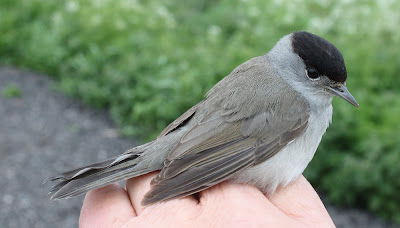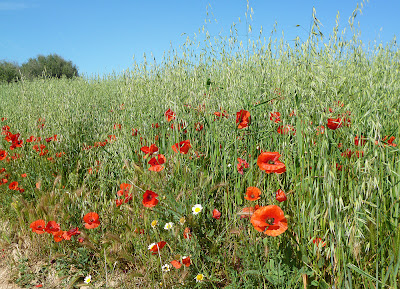No luck with the Lapwings or the Wheatears at Pilling today. The Lapwing chicks stayed in the muddy gullies where they can hide away as soon as the parents warn them. The Wheatears seemed wary of the trap and when I got a clear view of one of the males I saw it had a shiny ring - one of the birds I ringed two days ago. So it’s probably the same gang of Wheatears hanging about the sea wall and fattening up for the final push north. Other birds this morning: Buzzard, Reed Bunting, 2 Willow Warbler, Reed Warbler, Blackcap, Pied Wagtail.
For today’s post and for the birders I’m posting bird pictures from the recent Menorca holiday. To satisfy the just Menorca fans out there I’ve included photographs of island life and the landscape.
When we arrived on 28th April the marsh at Tirant was pretty much parched after some weeks of a dry spell. A wet spot in the centre of the marsh was just visible and where most species hung out, with Little Egrets, Purple and Grey Heron, Gadwall, Marsh Harrier, Squacco Heron, Black-winged Stilt, Little Grebe, Water Rail and Bee Eaters. Passerines included Woodchat Shrike, Corn Bunting, Tawny Pipit, Zitting Cisticola, Whinchat, Stonechat and the inescapable but unseen Nightingale and Cetti’s Warbler.
A Whiskered Tern fed over the reeds for two days, moving between here and the pool of Es Prat. There’s a record but not very good shot of the tern below, as Whiskered Terns are both fast and very active feeders. Unfortunately I wasn’t quick enough to photograph a Bittern which walked across the road in front of the car before disappearing into the reeds, a rare sighting in Menorca. Two sightings of Osprey here this year, fishing the open water and then feeding at the top of power pylons. During the last few days of the holiday up to 15 Wood Sandpipers graced the pools, unfortunately too distant to photograph.
Whiskered Tern
Black-winged Stlit
Es Prat, Menorca
Bee Eater
Woodchat Shrike
Rural Scene - Menorca
One day I glimpsed a turtle as it submerged into a muddy puddle: back home I looked my picture up on Google and I believe it to be Menorcan Turtle/European Pond Turtle Emys orbicularis. This turtle is quite distinct from the land based Hermann's Tortoise Testudo hermanni which we saw on one occasion just up the road from the marsh and along the dry, dusty track leading to the Tirant headland.
Menorcan Turtle
Hermann's Tortoise
From the headland it’s possible to walk to the shore, dunes and stream below where more Bee Eaters hang out, with Little Ringed Plover and Common Sandpiper on the water’s edge. Raptors near the headland proved to be a good number of Common Kestrels and Red Kites, with no Red-footed Falcon or Hobby this year, just a couple of fast-hovering Lesser Kestrels and the ever present Booted Eagles.
Booted Eagle
Heading west the road from Tirant leads up to Cap De Cavallaria and yet another cup of coffee at a favourite chill-out spot. Why is it you never get a bad cup of coffee in Menorca?
Towards Cap De Cavalleria
Cap De Cavalleria
More from Menorca or elsewhere soon on Another Bird Blog.






























































.jpg)












